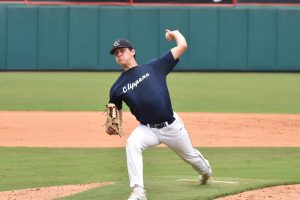High school baseball season is upon us. My son is a high school junior and recently verbally committed to pitch for a Division 1 school. He has worked hard to earn that offer, but the part most people do not see is the arm care and recovery work we do for him behind the scenes. Below is a recent picture of him in action.

I see lots of baseball players in my clinic ranging from 10 year olds to my MLB guys. One of the biggest issues I confront in my players (more commonly pitchers and catchers) is a condition known as internal impingement. While not the same thing as subacromial impingement, it still can impact the rotator cuff. Essentially, there is friction that causes irritation and in some cases injury to the rotator cuff and/or labrum. This usually manifests as pain in late cocking and the inability to throw hard without pain. Pitchers report decreased velocity and catchers struggle to thrown down to second with their their normal ease.
One of the most common issues leading to this is a loss of total shoulder motion on the throwing arm. Most notably, some players display significantly less internal rotation (IR) range of motion. Some loss of internal rotation is normal and expected over time provided they gain enough external rotation (ER) on the throwing side to counterbalance the asymmetry. Often, too much throwing early in the season or a big jump in pitch count/intensity/volume coupled with the ROM loss causes pain. This can occur suddenly or gradually build up over a few outings or games.
While there is certainly debate about whether this restricted motion is due to soft tissue or capsular tightness, the fact remains that pathological glenohumeral internal deficit (GIRD) is a risk factor for injury as it alters the normal mechanics of the shoulder. Research suggests that having total motion deficits of greater than 5 degrees on the throwing arm increases elbow injury risk (1). Personally, I believe that posterior shoulder tightness is likely related to some capsular tightness (happens over time with repetitive throwing), while the larger effect of high intensity eccentric load on the posterior shoulder with harder throwing creates a more acute effect in-season and especially after pitching.
What is the best way to treat internal impingement?
Based on experience treating players with this condition, treatment must consist of:
- Relative rest (this varies player to player based on phase of inflammation)
- Joint mobilization and posterior shoulder stretching
- Postural training and corrective exercises
- Scapular stabilizer/rotator cuff strengthening
Below is a paper from Manske et al. that looked at the benefit of adding joint mobilization to cross body stretching and its impact on internal rotation mobility versus stretching alone:
Manske et al. Sports Health 2010
Once the athlete has pain free ROM, negative impingement/labral special testing, has resolved GIRD and total ROM is within 5 degrees of the uninvolved side, they can safely resume a progressive throwing program. Return to pitching should be supervised by a qualified PT/ATC and coordinate with their pitching or baseball coach to ensure success.
A recent paper in Sports Health (2) revealed that both modified sleeper stretching (MSS) and modified cross body stretching (MCS) helped reduce pain and improve IR and total ROM in groups who had shoulder impingement. Using posterior shoulder stretching in addition to a traditional rehab plan was more effective in pain reduction and improving function. Click here for the abstract.
According to their paper, the two effective posterior shoulder stretches are:
- Modified sleeper stretch
- Modified cross body stretch
Both stretches studied involve a roll back of the trunk 20-30 degrees as described by Wilk et al. (3) to reduce potential for subacromial impingement. Click here to see a prior blog post of mine with video of these posterior shoulder stretches.
My goal as a father of a baseball pitcher and sports medicine physical therapist is to prevent these issues from becoming more serious where players suffer torn labrum, marked rotate cuff injury and potentially see their pithing career end. I encourage parents, coaches and players to seek out a qualified physiotherapist to perform a baseline evaluation in order to uncover postural, ROM, and/or strength asymmetries or imbalances that can lead to injury. Ideally, it would be a full body assessment as well.
Beyond that, seek out a skilled strength and conditioning coach who understands how to train baseball players as there are certain lifts that can cause more harm than good. I hope this info serves you well and good luck this Spring!
References:
1. Wilk KE, Macrina LC, Fleisig GS et al. Deficits in glenohumeral passive range of motion increase risk of elbow injury in professional baseball pitchers: a prospective study. Am J Sports Med. 2014 Sep;42(9):2075-81.
2. Tahran Ö, Yeşilyaprak SS. Effects of modified posterior shoulder stretching exercises on shoulder mobility, pain and dysfunction in patients with subacromial impingement syndrome. Sports Health. 2020 Mar/Apr;12(2):139-148.
3. Wilk KE, Hooks TR, Macrina LC. The modified sleeper stretch and modified cross-body stretch to increase shoulder internal rotation range of motion in the overhead athlete. J Orthop Sports Phys Ther. 2013;43:891-894.

